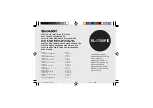
22
Using the Scratchpad
3. Type an expression and any other parameters required for the graph type.
4. Press
·
to graph the relation, or press
¤
to add another relation. If necessary,
you can use press
b 4
to choose a tool on the
Window/Zoom
menu and adjust
the viewing area.
When you graph the relation, the entry line disappears to show an uncluttered view
of the graph. If you select or trace a plot, the relation that defines the plot is
displayed on the entry line. You can modify a plot by defining a relation or by
selecting and changing the graph.
As you graph multiple plots, the defining relation is displayed for each. You can
define and graph a maximum of 99 relations of each type.
5. Use the
b
key to explore and analyse the relation to:
•
Trace the relation.
•
Find points of interest.
•
Assign a variable in the expression to a slider.
Viewing the Table
▶
To display a table of values corresponding to the current plots, press
b
> Table
> Split-screen Table
(
b 7 1
).
▶
To hide the table, click the graph side of the split screen, and then press
b
>
Table > Remove Table
(
b 7 2
). You can also press
Ctrl + T
.
▶
To resize columns, click the table and press
b
> Actions > Resize
(
b 1 1
).
▶
To delete a column, edit an expression, or edit table settings, click the table and
press
b
> Table
(
b 2
).
Changing the Appearance of the Axes
As you work with graphs, the Cartesian axes are displayed by default. You can change
the appearance of the axes in the following ways:
Summary of Contents for 5808730
Page 6: ...vi ...
















































